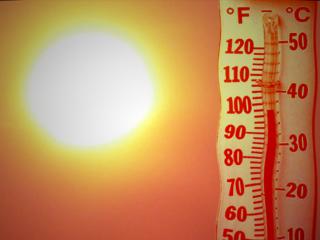People encouraged to prepare for potential heat warnings
British Columbians can expect higher temperatures as a high-pressure ridge is moving into B.C. and may result in heat warnings this weekend or early next week.
Hot and dry weather for many parts of British Columbia is predicted by Environment and Climate Change Canada. While the current forecast suggests a dip in daytime high temperatures late this week, there is potential for the high-pressure ridge to ramp up this weekend and into next week, which may lead to higher temperatures.
However, B.C. is not currently anticipating an extreme heat emergency. People are encouraged to monitor Environment and Climate Change Canada for temperature forecasts in their region.
A higher risk of heat-related illness is associated with increasing temperatures and it is critical people have a heat plan to keep safe. A heat plan should identify cool zones inside and outside of homes (such as community centres and libraries), ways to cool down (such as taking cool baths or showers and drinking plenty of water), and identify vulnerable family members and neighbours who are susceptible to heat and should be checked on.
Although heat is expected, bodies of water remain cool for this time of year and may pose a risk of hypothermia to people exposed to cold water for a prolonged period. People should also be cautious when near high or fast rivers and lakes.
The Province released an Extreme Heat Preparedness Guide in June to help people prepare for extreme heat with tips about how to stay safe when temperatures rise. The guide is available in French, Punjabi, traditional Chinese and simplified Chinese.
If there is a heat warning, communities may open a cooling centre. Please check with your First Nation or local government for the most up-to-date information.
In June, the Province announced the BC Heat Alert and Response System to establish temperature ranges and actions taken by government and communities under heat warnings and extreme heat emergencies.
Quick Facts:
- Heat illnesses include heat stroke, heat exhaustion, heat fainting, heat edema (swelling of hands, feet and ankles), heat rash and heat cramps (muscle cramps).
- People should watch for symptoms such as dizziness or fainting, nausea or vomiting, confusion, headache, rapid breathing and heartbeat, extreme thirst, and decreased urination with unusually dark yellow urine.
- If someone experiences any of these symptoms during extreme heat, they should immediately move to a cool place, start cooling down and drink liquids.
- If symptoms are not mild, last longer than one hour, change, worsen or cause concern, immediately contact a health-care provider.
Learn More:
PreparedBC’s Heat Preparedness Guide: www.preparedbc.ca/extremeheat
Find a cooling centre near you: https://www.emergencyinfobc.gov.bc.ca/find-a-cooling-centre-near-you/
Environment and Climate Change Canada’s weather alerts: https://weather.gc.ca/warnings/index_e.html?prov=bc
For more information about the BC Heat Alert and Response System: www.bccdc.ca/extremeheat
Follow PreparedBC on Facebook: www.facebook.com/PreparedBC
Follow PreparedBC on Twitter: www.twitter.com/PreparedBC
EmergencyInfoBC: https://www.emergencyinfobc.gov.bc.ca/
Follow EmergencyInfoBC on Twitter: https://twitter.com/EmergencyInfoBC
Environment and Climate Change Canada’s heat warning criteria: https://www.canada.ca/en/environment-climate-change/services/types-weather-forecasts-use/public/criteria-alerts.html#heat

























